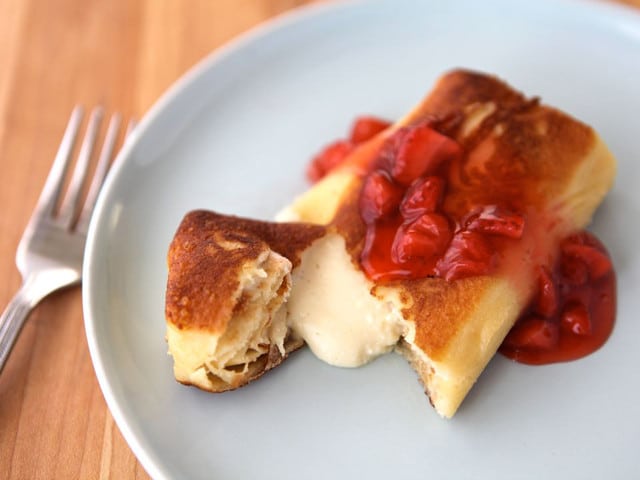Blintz
Blini ( [ blinɨ ], endbetont, Russian Блины, actually plural, singular is flashing, блин? / I ), ( Western ) Europeanized blinis are a native of Eastern Europe kind of sponge cake. They are prepared in the form of thin pancake, eaten hot and partially rolled up with a variety of fillings and spreads. The typical spread in Russia is butter. Other common supplements are cottage cheese, ground beef, salted smoked fish (herring, sprats, sardines, salmon) or caviar. At tea they are served with sour cream, jam, honey, cheese or sweetened condensed milk.
The recipe for blinis comes from the rural population of Russia since the pancakes are cheap and easy to prepare.
The dough for real Russian blinis is prepared with yeast, different flour or meal and water and mostly prepared without sweetener or sweet sauce or filling. After going to improve the taste cooking oil, hot milk, whipped cream or beaten egg whites can be added with the dough then a second time goes. Historical Bliny predominantly consisted of buckwheat flour.
Pancake made of dough without yeast, but on pure milk to go and possibly sugar and sweet filling is called contrast Блинчики ( blinčiki ).
The egg tarts are baked in special small cast-iron handle -less blinis pans and are only a few millimeters thick. The pan is lightly greased with a case in edible oil dipped onion brush ( impaled on a fork onion half) before each new pancake. The dough should be poured from a portioned wooden spoon in the pan. The finished blinis are immediately spread with butter and stacked. In a traditional Russian meal Bliny be ( German: snack or appetizers ) to the cold Zakuski served before the soup.
Etymology and word usage
The word is a plural form of блин ( flashing ) and going back to old Russian млинъ / блинъ ( mlin / flashing ) " pancake ". The word is probably " grind " to connect to the verb молоть ( molot '). Another approach runs it on a reconstructed stem * бълинъ " Aufgeschwollenes " back, which could be related with the Germanic word bump. In Ukrainian hot pancakes today млинці ( mlynci, with Wortbildungssuffix -ec ). The spread in Germany expression " blintzes " for egg cake was borrowed from Upper Sorbian plinc before the 16th century.
Outside Russia, the word Bliny is often used for various dishes that are reminiscent in form of blinis. This can also lead to narrowing of meaning, as it simply those Russian pancakes will be referred to, differ from the locals. In Russian, however, the word Bliny is a general term for any kind of thin and large pancakes. Often in the West, the term Bliny is also falsely applied for small, thick pancakes, which are called in Russian actually оладьи ( olad'i ).
In the U.S., where they have come by Jewish immigrants, they are referred to with the coming from the Yiddish word blintz ( cf. Yiddish. בלינצע blintze ), which dates back to the Upper Sorbian word plinc about the German blintzes.
The Russian is also a blind Hüllwort for a general condemnation curse ( " Crap! " ) To avoid the vulgar блядь ( bljad ') " whore ", comparable to the German Sheesh.
Dissemination
Bliny allegedly had some ritual significance among the ancient Slavs in pre-Christian times since they were a symbol of the sun, thanks to its round shape.
Since the Middle Ages, they are baked in Russia at the end of winter to Maslenitsa ( Pancake week ) to symbolically celebrate the rebirth of the sun, before the start of Lent. They were previously offered this week by street vendors. This tradition was adopted by the Russian Orthodox Church and is maintained until today. Others for Bliny meals were the ritual observances for the dead, which were held three times a year. Even at funerals blinis were prepared as meals for the guests.
Similar Teigspeisen are widespread throughout eastern and southeastern Europe, but only occasionally made from buckwheat flour. Polish pancakes hot naleśniki if they are prepared without yeast, and Racuchy when it comes to Hefepfannkuchen. In the Czech Republic they are called palačinky, Hungary Palacsinta ( pancakes ). By Russian (mainly Jewish ) immigrants buckwheat pancakes have become well known in the United States.
Bliny in Russian literature
- In the story, the simpleton of the Chekhov strange for a Frenchman, typical Russian property is described to destroy a large amount of Bliny at once.
- In the story, the iron will of Leskov, which describes the tragikomödischen Adventure of the German Hugo pectoralis in Russia, the protagonist eventually dies by choking on a Bliny.
- In Nimmer Klugs trip to the moon by NNNossow explains Always Klug ( Незнайка Луне на ) the origin of lunar craters on the example of the holes in Bliny.










